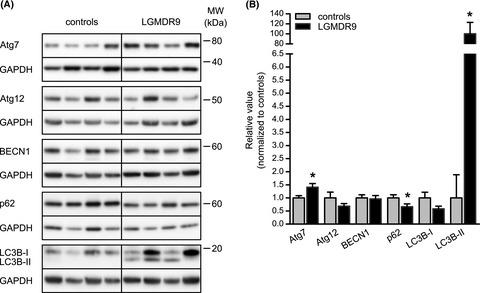当前位置:
X-MOL 学术
›
Neuropathol. Appl. Neurobiol.
›
论文详情
Our official English website, www.x-mol.net, welcomes your
feedback! (Note: you will need to create a separate account there.)
Protein homeostasis in LGMDR9 (LGMD2I) – The role of ubiquitin‐proteasome and autophagy‐lysosomal system
Neuropathology and Applied Neurobiology ( IF 4.0 ) Pub Date : 2021-01-20 , DOI: 10.1111/nan.12684 Veronika Franekova 1 , Hilde I Storjord 2 , Gunnar Leivseth 1 , Øivind Nilssen 1, 3
Neuropathology and Applied Neurobiology ( IF 4.0 ) Pub Date : 2021-01-20 , DOI: 10.1111/nan.12684 Veronika Franekova 1 , Hilde I Storjord 2 , Gunnar Leivseth 1 , Øivind Nilssen 1, 3
Affiliation

|
AIMS
Limb-girdle muscular dystrophy R9 (LGMDR9) is an autosomal recessive disorder caused by mutations in the fukutin-related protein gene (FKRP), encoding a glycosyltransferase involved in α-dystroglycan modification. Muscle atrophy, a significant feature of LGMDR9, occurs by a change in the normal balance between protein synthesis and protein degradation. The ubiquitin-proteasome system (UPS) and autophagy-lysosomal system play a key role in protein degradation in skeletal muscle cells, but their involvement in the pathology of LGMDR9 is still largely unknown. We have aimed at clarifying whether proteolysis through the UPS and the autophagy-lysosomal pathway is dysregulated in LGMDR9 patients. METHODS
Vastus lateralis biopsies from 8 normal controls and 12 LGMDR9 patients harbouring the c.826C>A/c.826C>A FKRP genotype were assessed for protein markers related to UPS, the autophagy-lysosomal system and endoplasmic reticulum (ER) stress/unfolded protein response (UPR), followed by ultrastructural analysis by transmission electron microscopy (TEM). RESULTS
Protein levels of E3 ubiquitin ligases Atrogin-1 and MuRF1 showed a pattern similar to normal controls. Elevation of the autophagy markers Atg7, LC3B-II, decreased level of p62 as well as downregulation of the negative autophagy regulator mTORC1, indicated an activation of autophagy in LGMDR9. Mitophagy markers Bnip3 and Parkin were decreased. TEM analysis demonstrated accumulation of autophagosome-like structures in LGMDR9 muscle. There was also an increase in the expression of ER stress/UPR markers PDI, peIF2α and CHOP and a decrease of IRE1α. However, GRP94, Bip and Calnexin remained unchanged. CONCLUSION
Our findings indicate that autophagy and ER stress are induced in LGMDR9 muscle.
中文翻译:

LGMDR9 (LGMD2I) 中的蛋白质稳态——泛素-蛋白酶体和自噬-溶酶体系统的作用
AIMS 肢带型肌营养不良症 R9 (LGMDR9) 是一种常染色体隐性遗传病,由 fukutin 相关蛋白基因 (FKRP) 突变引起,该基因编码参与 α-肌营养不良聚糖修饰的糖基转移酶。肌肉萎缩是 LGMDR9 的一个重要特征,它是由蛋白质合成和蛋白质降解之间的正常平衡发生变化而发生的。泛素-蛋白酶体系统 (UPS) 和自噬-溶酶体系统在骨骼肌细胞的蛋白质降解中起关键作用,但它们在 LGMDR9 病理学中的作用仍然很大程度上未知。我们旨在阐明通过 UPS 和自噬-溶酶体途径的蛋白水解是否在 LGMDR9 患者中失调。方法 来自 8 名正常对照和 12 名携带 c.826C>A/c.826C> 的 LGMDR9 患者的股外侧肌活检 评估 FKRP 基因型的与 UPS、自噬溶酶体系统和内质网 (ER) 应激/未折叠蛋白反应 (UPR) 相关的蛋白质标志物,然后通过透射电子显微镜 (TEM) 进行超微结构分析。结果 E3 泛素连接酶 Atrogin-1 和 MuRF1 的蛋白质水平显示出与正常对照相似的模式。自噬标志物 Atg7、LC3B-II 的升高、p62 水平的降低以及负性自噬调节剂 mTORC1 的下调,表明 LGMDR9 中自噬的激活。线粒体自噬标志物 Bnip3 和 Parkin 减少。TEM 分析表明 LGMDR9 肌肉中自噬体样结构的积累。ER应激/UPR标志物PDI、peIF2α和CHOP的表达也增加,IRE1α减少。然而,GRP94、Bip 和 Calnexin 保持不变。
更新日期:2021-01-20
中文翻译:

LGMDR9 (LGMD2I) 中的蛋白质稳态——泛素-蛋白酶体和自噬-溶酶体系统的作用
AIMS 肢带型肌营养不良症 R9 (LGMDR9) 是一种常染色体隐性遗传病,由 fukutin 相关蛋白基因 (FKRP) 突变引起,该基因编码参与 α-肌营养不良聚糖修饰的糖基转移酶。肌肉萎缩是 LGMDR9 的一个重要特征,它是由蛋白质合成和蛋白质降解之间的正常平衡发生变化而发生的。泛素-蛋白酶体系统 (UPS) 和自噬-溶酶体系统在骨骼肌细胞的蛋白质降解中起关键作用,但它们在 LGMDR9 病理学中的作用仍然很大程度上未知。我们旨在阐明通过 UPS 和自噬-溶酶体途径的蛋白水解是否在 LGMDR9 患者中失调。方法 来自 8 名正常对照和 12 名携带 c.826C>A/c.826C> 的 LGMDR9 患者的股外侧肌活检 评估 FKRP 基因型的与 UPS、自噬溶酶体系统和内质网 (ER) 应激/未折叠蛋白反应 (UPR) 相关的蛋白质标志物,然后通过透射电子显微镜 (TEM) 进行超微结构分析。结果 E3 泛素连接酶 Atrogin-1 和 MuRF1 的蛋白质水平显示出与正常对照相似的模式。自噬标志物 Atg7、LC3B-II 的升高、p62 水平的降低以及负性自噬调节剂 mTORC1 的下调,表明 LGMDR9 中自噬的激活。线粒体自噬标志物 Bnip3 和 Parkin 减少。TEM 分析表明 LGMDR9 肌肉中自噬体样结构的积累。ER应激/UPR标志物PDI、peIF2α和CHOP的表达也增加,IRE1α减少。然而,GRP94、Bip 和 Calnexin 保持不变。











































 京公网安备 11010802027423号
京公网安备 11010802027423号